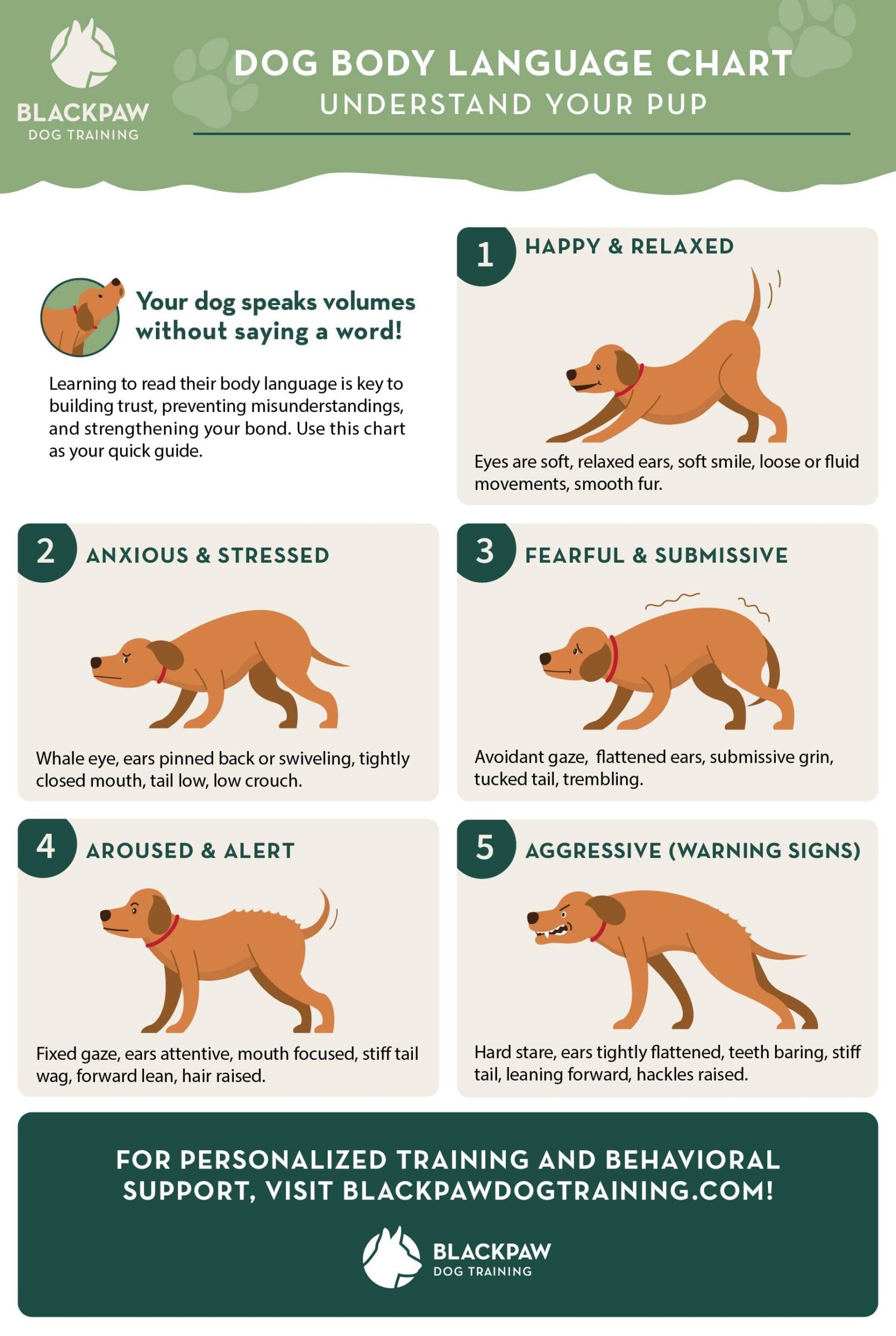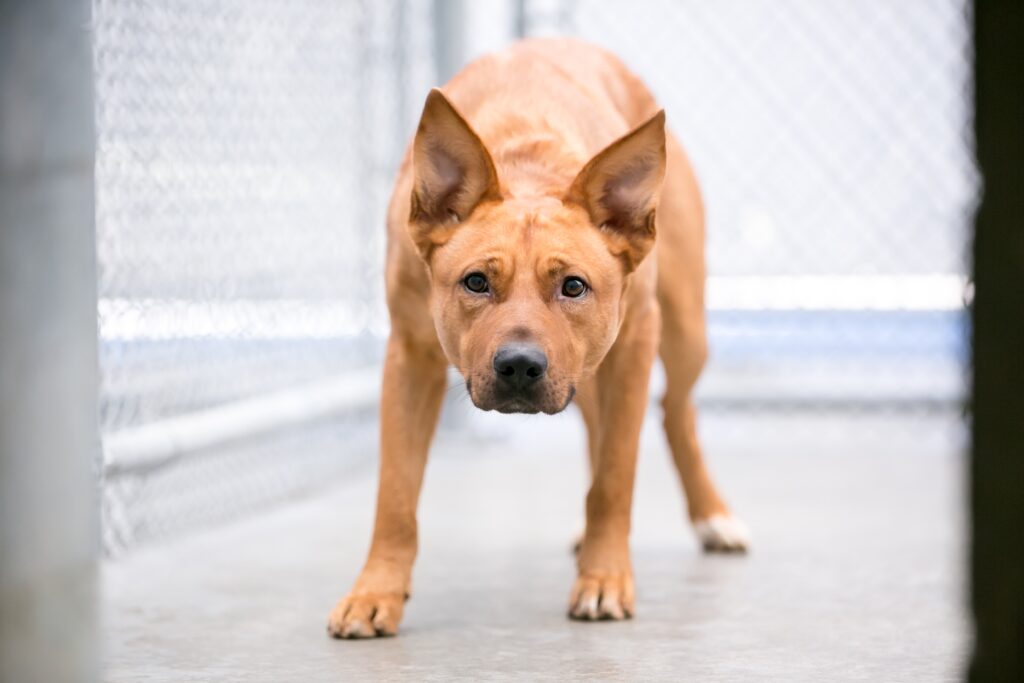BlackPaw’s Dog Body Language Chart + How to Understand It
Ever wished you had a secret decoder ring for your dog’s barks, wiggles, and wags? Well, good news! While we can’t offer a magic ring, we can give you the next best thing: a comprehensive dog body language chart designed to help you finally “speak dog.” Your furry friend is communicating with you constantly, from the tip of their nose to the end of their tail – and learning to interpret these subtle (and not-so-subtle) signals is one of the most rewarding adventures you’ll ever embark on as a dog owner. Get ready to unlock a deeper bond, prevent misunderstandings, and truly connect with your beloved pup!
Why We’ve Created This Dog Body Language Chart
Here at BlackPaw Dog Training, we’ve seen countless “uh-oh” moments that could have been avoided with a little more understanding. Sometimes, a worried look is mistaken for stubbornness, or a play bow for aggression. We believe that truly effective communication is the secret sauce for every happy dog-owner relationship. Misinterpreting your dog’s signals can lead to frustration for both of you and sometimes even escalate into unwanted behaviors or uncomfortable situations. That’s why we poured our expertise into creating this easy-to-follow, comprehensive dog body language chart. Our mission? To empower you with the knowledge to finally decipher their silent language, fostering a more harmonious, joyful, and downright telepathic life together!
The Importance of Understanding Dog Body Language
Dogs don’t speak human languages, but they are masters of non-verbal communication. From the tip of their nose to the end of their tail, every part of their body contributes to conveying their emotional state, intentions, and needs. By learning to read dog body language, you can:
- Prevent Issues: Spot early signs of stress, fear, or discomfort before they escalate into growling, snapping, or other reactive behaviors.
- Build Trust: Respond appropriately to your dog’s feelings, showing them you understand and respect their boundaries.
- Deepen Your Bond: Forge a stronger connection rooted in clear communication and mutual understanding.
- Ensure Safety: Know when it’s safe for your dog to interact with others, and when they need space or protection.
- Improve Training: Understand if your dog is engaged, confused, or stressed during training sessions, allowing you to adapt your approach.
Understanding body language in dogs is not just a skill; it’s an act of love that transforms your relationship.
Here’s Our Dog Body Language Chart

Reading a Relaxed & Happy Dog
A dog at ease is a joy to behold. Their signals are often fluid and loose, indicating comfort and contentment.
- Eyes: A happy dog has soft, relaxed eyes, often appearing almond-shaped. Their gaze might be gentle and not fixed. You’ll see regular blinking, and pupils will be a normal size.
- Ears: When a dog is relaxed, their ears will be in a natural position for their breed – neither stiffly pricked forward nor flattened against the head. They might be slightly to the side or loose, indicating comfort.
- Mouth: A relaxed mouth can be closed or slightly open, often with a soft, relaxed pant (if not exerting themselves). A “soft smile,” where the corners of the mouth are slightly upturned without any tension in the lips, is a common sign of happiness. You won’t see any lip-licking (unless they just ate!) or yawning out of context.
- Tail: A relaxed tail will often be held in a neutral position (which varies by breed) or exhibit a loose, gentle wag that sweeps side to side. The entire body might participate in the wag, signifying overall contentment.
- Body Posture: A happy dog’s body will appear loose and fluid. They might stand with their weight evenly distributed, or lie in a relaxed position, perhaps with their legs splayed out. There’s no rigidity or tension.
- Fur: Their fur will lie smooth, with no piloerection (hackles raised) along the spine.
Spotting an Anxious & Stressed Dog
Recognizing early signs of anxiety or stress in your dog is crucial for intervention and building trust. These signals often indicate internal discomfort.
- Eyes: The infamous “whale eye” is a classic sign where the whites of the eyes are visible, often when the dog turns their head away but still looks at the perceived threat. Eyes might also be wide, darting, or pupils could be dilated.
- Ears: Ears that are flattened against the head, pulled back, or constantly swiveling back and forth, trying to catch every sound, often indicate stress or uncertainty.
- Mouth: A tightly closed mouth, excessive panting when not hot or exerting themselves, repeated lip licking, or yawning out of context are all common stress signals. You might also notice drooling.
- Tail: A tucked tail held low and stiff, or a low, rapid wag that feels tense rather than loose, are clear signs of anxiety or discomfort.
- Body Posture: A stressed dog might crouch low, lean away from something, pace restlessly, or tremble. Their body might appear rigid, ready to bolt or freeze.
- Fur/Hair: Piloerection, or “hackles,” can appear along the neck and shoulders, indicating arousal or fear, even before overt signs of aggression.
Interpreting a Fearful & Submissive Dog
Fear and submission are often closely linked. These signals are an attempt to de-escalate a perceived threat and avoid conflict.
- Eyes: A fearful dog will often avoid direct eye contact, looking away, or squinting. Their gaze might seem shifty.
- Ears: Ears are typically flattened tightly against the head and pulled back.
- Mouth: The mouth might be closed and tight, with repeated lip licking or yawning. A “submissive grin,” where the corners of the mouth are pulled back slightly, exposing teeth without a snarl, can also occur. Drooling might be present.
- Tail: The tail is usually tucked tightly between the legs, often completely hidden. It might also show a very low, slow, tense wag.
- Body Posture: A fearful dog will often crouch low, try to make themselves small, or even roll onto their back to expose their belly (a sign of extreme submission). Trembling is common, and they might even urinate.
- Fur/Hair: Piloerection is possible, particularly if fear is combined with arousal.
Understanding an Aroused & Alert Dog
An alert dog is highly focused on something in their environment. This state can quickly transition to either a positive (e.g., play) or negative (e.g., aggression) response depending on the context.
- Eyes: Their gaze will be fixed and intense, pupils often dilated, fully focused on the object of their attention.
- Ears: Ears will be pricked forward and highly attentive, swiveling to pinpoint sounds.
- Mouth: The mouth is often closed or slightly open, with a focused expression. You might see a subtle lip curl if arousal is tinged with uncertainty.
- Tail: The tail is typically held high and stiff, often with a rapid, flag-like wag, or held straight out behind them.
- Body Posture: The dog’s body will appear rigid, possibly leaning forward, ready to react. They might seem “frozen” for a moment as they process.
- Fur/Hair: Piloerection is common with arousal, indicating heightened emotional state.
Recognizing Aggressive (Warning) Signs
Aggressive displays are serious warnings. Understanding these signals is critical for safety and should prompt immediate intervention. If you’re observing consistent signs of aggression in your dog, particularly fear-based aggression, seeking professional guidance from experts in areas like fear-aggression training is paramount.
- Eyes: A hard, fixed stare, often accompanied by constricted pupils.
- Ears: Ears can be stiffly pricked forward (offensive aggression) or flattened tightly back (fear aggression).
- Mouth: Lips curled back to expose teeth (a snarl), growling, a low, guttural bark, or snapping.
- Tail: Can be held high and stiff, with a rapid, low amplitude wag, or tucked tight if fear is driving the aggression.
- Body Posture: The body is stiff and rigid, often leaning forward or standing tall to appear larger. Lunging or freezing before a lunge.
- Fur/Hair: Prominent piloerection (hackles) along the entire spine is a strong indicator of aggression or intense fear/arousal.
Beyond the Chart: Real-World Application
While our dog body language chart provides a fantastic foundation, remember that context is everything. Always consider your dog’s environment, recent events, and the full range of their body signals (not just one isolated tail wag!) when interpreting their communication. Practice observing your dog in different situations:
- At the dog park: Watch how they interact with other dogs. Are they seeking play or trying to de-escalate a tense situation?
- Meeting new people: Are they confident, hesitant, or trying to avoid interaction?
- During vet visits: Look for subtle signs of stress or fear that your vet can address.
- During training sessions: Are they engaged and happy, or are they showing signs of confusion or discomfort?
This ongoing observation and learning process will refine your ability to read your dog like an open book, strengthening your relationship day by day.
Understand Your Dog’s Body Language to Bring You Both Closer
Truly understanding your dog’s non-verbal cues is one of the most powerful tools you can possess as a pet owner. It’s the key to unlocking a deeper level of communication and building an unbreakable bond based on mutual respect and understanding. When you grasp the nuances of dog body language, you can anticipate your dog’s needs, recognize early signs of stress or discomfort, and celebrate their joy and contentment with greater clarity. This knowledge empowers you to be a more responsive, empathetic, and effective companion.
Ultimately, investing time in understanding body language in dogs leads to a more harmonious household. It allows you to intervene before small anxieties become big problems, prevent misunderstandings that could lead to fear or frustration, and ensure your dog feels truly seen and heard. This level of insight helps create a more confident, well-adjusted, and happy canine companion.
Here’s What to Know About Intensive Dog Training and Boarding
Book With BlackPaw Dog Training Today
If you find yourself with specific behavioral concerns or want to dive even deeper into canine communication and advanced training, don’t hesitate to reach out. For comprehensive training solutions, explore our Perfect Pooch Program or, for more challenging behaviors, consider our Total Behavior Reboot. We also offer advanced training options, including insights into E Collar training for dogs for precision control. At BlackPaw Dog Training, we’re dedicated to helping you strengthen the bond with your furry friend through clear communication and positive, effective training methods. Contact us today to learn how we can support you and your pup on your journey together!

